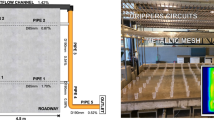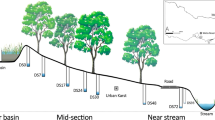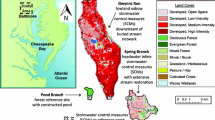Abstract
Urban karst systems are typically considered more vulnerable to contamination and excess storm discharge because of potential source areas, increased sediment loading, and focusing of water from impervious surfaces. However, urban hydrology can lead to unexpected patterns, such as pirating of recharge into man-made storm systems. Valley Creek Basin in southeastern Pennsylvania, presents such an urban karst system. Four springs were monitored for suspended sediment, water chemistry, and storm response for an 18-month period. The baseflow suspended sediment concentrations were low, less than 4.0 mg/l. Furthermore, trace metal analysis of baseflow water samples and spring mouth sediment showed only low concentrations. The response to storms within the system was rapid, on the order of 1–3 h. The maximum water stage increases at the urban springs were typically less than 15 cm, with springs from more commercialized areas showing <2 cm increase. A nearby retention basin, in contrast, had water level rises of 100 cm, suggesting that pirating of recharge into stormwater systems occurs. Thus, the concept of an urban karst system as a contaminant conduit is not the only one that applies. In Valley Creek Basin, reduced infiltration due to paving led to smaller storm response and less contaminant input, and the smaller capture area due to diversion of stormwater led to short flow paths and rapid storm response. Although contaminant levels have not increased due to urbanization, the springs may be at risk for future contamination. Short flow paths may reduce flushing, which means that the system will not cleanse itself if contamination occurs.







Similar content being viewed by others
References
Brencic M (2006) Groundwater and highways interaction; past and present experiences of highway construction in Slovenia. Env Geol 49:804–813
Chester County Water Resource Authority (2004) Valley Creek watershed technical compendium. http://dsf.chesco.org/water (Cited August 2005)
Dussart-Baptista L, Massei N, Dupont JP, Jouenne T (2003) Transfer of bacteria-contaminated particles in a karst aquifer; evolution of contaminated materials from a sinkhole to a spring. J Hydrol 284:285–295
Fischer JM, Riva-Murray K, Hickman RE, Chichester DC, Brightbill RA, Romanok KM, Bilger MD (2004) Water quality in the Delaware River Basin, Pennsylvania, New Jersey, New York, and Delaware, 1998–2001. US Geological Survey Circular 2004-1227, 48 p
Freeze RA, Cherry JA (1979) Groundwater. Prentice-Hall, Englewood Cliffs
Green CS (2000) The effects of urbanization on a karst terrane; Bowling Green, Kentucky. Abstracts with programs, Geological Society of America 32:15
Gross K (2007) Analysis of effects of urbanization on spring geochemistry and sediment for a karst aquifer in Valley Creek Basin, Chester County, Pennsylvania. MS Temple University, Philadelphia
Gutierrez M, Neill H, Grand RV (2004) Metals in sediments of springs and cave streams as environmental indicators in karst areas. Eng Geol 46:1079–1085
Hess JW, White WB (1988) Storm response of the karstic carbonate aquifer of Southcentral Kentucky. J Hydrol 99:235–252
Hoetzl H (1999) The nature of human impacts on karst waters; industrial and urban produced impacts. In: Drew D, Hoetzl H (eds) Karst hydrogeology and human activities impacts consequences and implications. International contributions to hydrogeology. Balkema, Rotterdam, vol 20, pp 81–185
Kochanov WE (1993) Areal analysis of karst data from the Great Valley of Pennsylvania. In: Beck BF (ed) Applied karst geology. Rotterdam, Balkema, pp 37–41
Llado LE (2007) Springflow trends in the Edwards Aquifer; long term urbanization effects. Abstracts with Programs, Geological Society of America 39:5
Loop CM, White WB (2001) A conceptual model for DNAPL transport in karst ground water basins. Ground Water 39:119–127
MacDonald DD, Ingersoll CG, Berger TA (2000) Development and evaluation of consensus-based sediment quality guidelines for freshwater ecosystems. Arch Environ Contam Toxicol 39:20–31
Mahler BJ, Lynch FL (1999) Muddy waters; temporal variation in sediment discharging from a karst spring. J Hydrol 214:165–178
Mahler B, Massei N (2007) Anthropogenic contaminants as tracers in an urbanizing karst aquifer. J Contam Hydrol 91:81–106
Mahler BJ, Lynch L, Bennett PC (1999) Mobile sediment in an urbanizing karst aquifer; implications for contaminant transport. Environ Geol 39:25–38
Mahler BJ, Garner BD, Massei N (2005) Use of geochemical tracers in karst spring flow for identification and apportionment of contaminant source. Abstracts with Programs, Geological Society of America 37:325
Massei N, Mahler BJ, Bakalowicz M, Fournier M, Dupont JP (2007) Quantitative interpretation of specific conductance frequency distributions in karst. Ground Water 45:288–293
McGinty A (2003) Geostatistical analysis of the impacts of urbanization on spring water quality in Valley Creek Watershed, Chester County, Pennsylvania. MS Drexel University, Philadelphia
Panno SV, Hackley KC, Hwang HH, Greenberg SE, Krapac IG, Landsberger S, O’Kelly DJ (2006) Characterization and identification of Na–Cl sources in ground water. Ground Water 44:176–187
Parkhurst DL, Appelo CAJ (1999) User’s guide to PHREEQC (version 2); a computer program for speciation, batch-reaction, one-dimensional transport, and inverse geochemical calculations. US Geological Survey, Water-Resources Investigations WRI 99-4259
Sharp JM, J. Krothe JN, Mather JD, Garcia-Fresca B, and Stewart CA (2003) Effects of urbanization on groundwater system. In: Heiken G, Fakundiny R, Sutte J (eds) Earth science in the city: a reader. American Geophysical Union, Washington, DC, pp 257–278
Shuster ET, White WB (1971) Seasonal fluctuations in the chemistry of limestone springs; a possible means for characterizing carbonate aquifers. J Hydrol 14:93–128
Sloto RA (1990) Geohydrology and simulation of ground-water flow in the carbonate rocks of the Valley Creek basin, eastern Chester County, Pennsylvania. US Geological Survey, Water-Resources Investigations WRI 89-4169
Steffy LY, Kilham SS (2006) Effects of urbanization and land use on fish communities in Valley Creek watershed, Chester County, Pennsylvania. Urban Ecosyst 9:119–133
Stephenson JB, Zhou WF, Beck BF, Green TS (1999) Highway stormwater runoff in karst areas; preliminary results of baseline monitoring and design of a treatment system for a sinkhole in Knoxville. Tennessee Eng Geol 52:51–59
Toran L, Tancredi J, Herman EK, White WB (2006) Conductivity and sediment variation during storms as evidence for pathways in karst springs. In: Wicks CM, Harmon RS (eds) Geological Society of America Special Paper 404 in honor of Derek Ford and William B. White, pp 169–176
Vesper DJ, White WB (2003) Metal transport to karst springs during storm flow; an example from Fort Campbell, Kentucky/Tennessee, USA. J Hydrol 276:20–36
Yang Y (2006) Characterizing storm response in an urban karst aquifer at Valley Creek, Chester County, Pennsylvania. MS Temple University, Philadelphia
Acknowledgments
We would like to thank Claire Welty of University of Maryland-Baltimore County for introducing us to the springs of Valley Creek Basin, and the East Whiteland Township and landowners who provided access to the springs. Dr. Ellen Herman, Sam Panno, and an anonymous reviewer provided helpful comments on an earlier version of this manuscript. Funding for this project was provided by the National Science Foundation Hydrologic Sciences Program under Award No. 125601.
Author information
Authors and Affiliations
Corresponding author
Rights and permissions
About this article
Cite this article
Toran, L., Gross, K. & Yang, Y. Effects of restricted recharge in an urban karst system. Environ Geol 58, 131–139 (2009). https://doi.org/10.1007/s00254-008-1500-0
Received:
Accepted:
Published:
Issue Date:
DOI: https://doi.org/10.1007/s00254-008-1500-0




